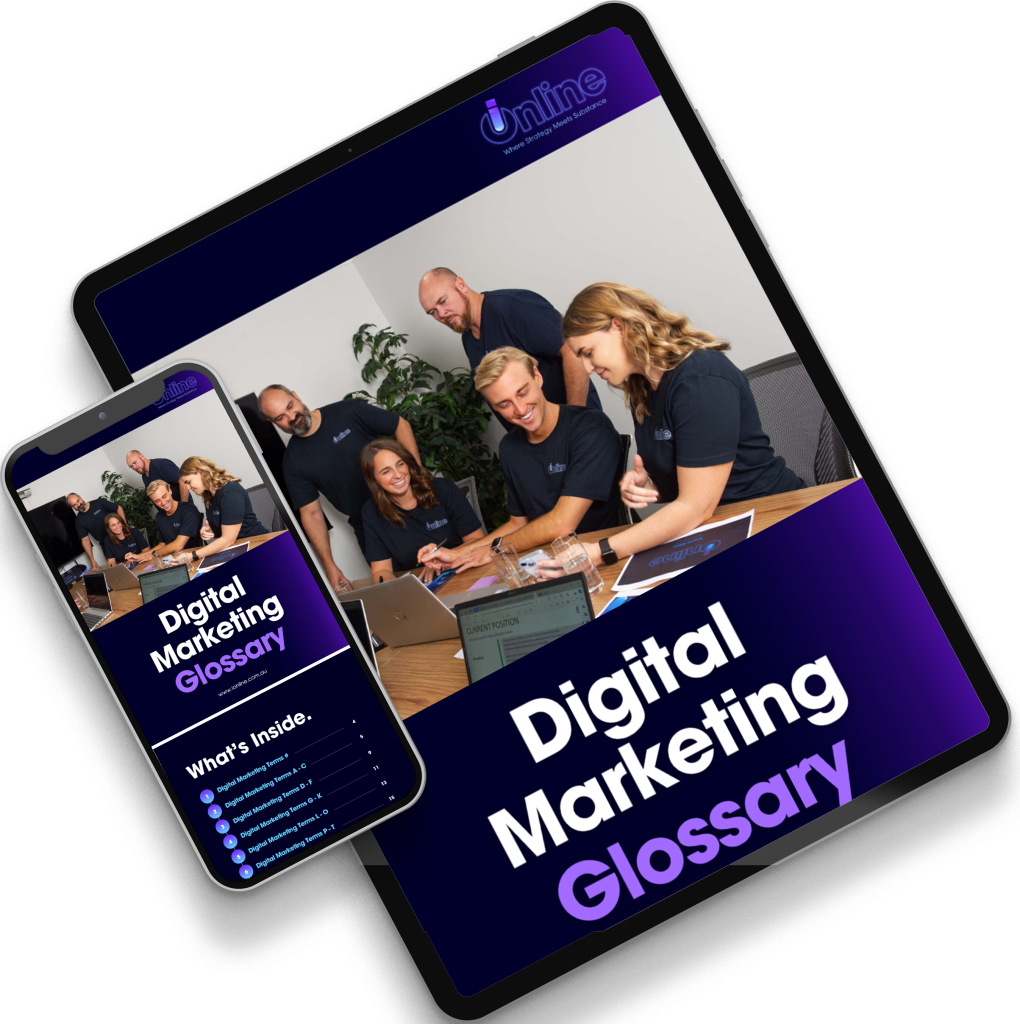In the fast-paced world of digital marketing, it’s easy to feel overwhelmed by the industry jargon and technical terms.
At iOnline, we believe that having a solid understanding of these terms is key to making informed decisions and getting the most out of your marketing strategy.
That’s why we’ve put together this Digital Marketing Glossary—a helpful resource designed to demystify the most common terms used in the industry.
Whether you’re a business owner or a marketing professional, this glossary will equip you with the knowledge you need to navigate the world of digital marketing with confidence.

Don’t miss out on the complete collection of essential digital marketing terms! Download your free copy of the full glossary and stay ahead with the latest insights
An HTTP status code indicating that a request was successfully processed by the server, and the user is being directed to the intended destination URL.
An HTTP status code used to signal that a URL has been permanently moved to a new location. When a server responds with a 301, browsers are automatically redirected to the updated URL.
This HTTP status code signals that the requested URL has been temporarily moved to a different location but will return to its original place later.
A type of HTTP status code that appears when the server cannot find the requested page or file. This could mean the page was deleted, or it never existed. Redirecting 404s to an appropriate page can help retain user traffic.
An HTTP status code that indicates an issue with the server, preventing it from processing the request. These errors usually include an explanation, whether the problem is temporary or permanent.
An experiment where two versions of a webpage, email, or ad are compared to see which performs better. It helps determine which elements resonate more with your audience, improving your marketing strategy.
Refers to the content that is visible to users before they scroll down the page. It’s essential to place important information above the fold to capture attention immediately.
Additional information that appears below Google Ads, such as site-links, call outs, or pricing. These extensions improve visibility and can increase click-through rates by offering more detailed information.
A set of ads targeting a similar group of keywords in paid advertising. Organising ads into groups allows for better control and optimisation.
A metric used in paid search campaigns to measure how closely your ad content aligns with the targeted keywords. Higher relevance often leads to better performance.
Determining which marketing channel or touch point contributed to a conversion, such as a sale or lead. Attribution models help marketers understand how various interactions in the customer journey contribute to the final action.
Refers to businesses that provide products or services to other businesses rather than directly to consumers.
Refers to companies that sell directly to individual consumers.
An external link from another website that points to your site. Backlinks are crucial for SEO as they signal to search engines that your site is trustworthy and authoritative.
A form of digital advertisement, typically image-based, displayed on websites or apps. These ads aim to drive traffic to a landing page through a clickable link.
A statistical method that updates the probability of an outcome based on new data. This approach allows marketers to incorporate previous insights to predict performance outcomes better.
The maximum amount an advertiser is willing to pay per click in paid search campaigns. Higher bids often lead to better ad placements for targeted keywords.
A plan within Google Ads to optimise campaigns toward specific goals. You can choose between bidding for clicks, conversions, or impressions based on your objectives.
Unscrupulous practices that violate search engine guidelines, such as keyword stuffing or buying low-quality backlinks. These tactics may result in penalties from search engines.
The percentage of visitors who leave your site after viewing only one page. A high bounce rate can signal irrelevant content or poor user experience.
A navigation aid displayed at the top of a webpage, showing the path taken to reach the current page. For example, Home > Products > Electronics > Laptops.
A link that no longer leads to an active webpage. This can happen if the linked page has been removed or the URL was entered incorrectly.
A link that no longer leads to an active webpage. This can happen if the linked page has been removed or the URL was entered incorrectly.
An HTML attribute used to tell search engines which version of a webpage is the “master” version when multiple versions exist, helping to avoid duplicate content issues.
A desired action taken by a user on your website, such as purchasing a product, signing up for a newsletter, or filling out a contact form.
The process that leads a user from awareness to taking a specific action, like making a purchase. Optimising each step of the funnel improves conversion rates.
The process that leads a user from awareness to taking a specific action, like making a purchase. Optimising each step of the funnel improves conversion rates.
Small pieces of data stored on a user’s device by a website. Cookies are used to remember user preferences and track online behaviour, often for targeted marketing purposes.
The amount an advertiser pays each time someone clicks on their ad. CPC is commonly used in paid search and social media advertising.
The practice of improving your website’s design and content to increase the percentage of visitors who take a desired action, such as making a purchase.
The practice of improving your website’s design and content to increase the percentage of visitors who take a desired action, such as making a purchase.
A metric that measures how many people clicked on an ad or link compared to how many people saw it. A higher CTR indicates that your ad is engaging and relevant.
A system used to collect, organise, and activate large sets of data from different sources, typically for improving ad targeting.
The use of digital channels such as search engines, social media, email, and websites to promote products or services. Digital marketing allows for real-time data collection and analysis to improve marketing efforts.
A type of online advertising that involves placing visual ads, such as banners or videos, on third-party websites or apps to attract attention and drive traffic.
A metric developed by Ahrefs that reflects the authority and ranking potential of a website based on its backlink profile.
Exposure gained through unpaid means, such as media coverage, customer reviews, or social shares. Unlike paid or owned media, earned media is often viewed as more credible.
The buying and selling of goods and services online. E-commerce businesses use digital platforms to conduct transactions with consumers or other businesses.
A form of direct marketing that uses email to promote products, services, or events to potential or existing customers.
A metric that measures how users interact with your content on social media, such as likes, shares, comments, or clicks.
Content that remains relevant and valuable over time, such as how-to guides, tutorials, or case studies. Evergreen content continues to attract traffic long after it’s published.
A platform that allows businesses to create and run ads within Facebook’s ecosystem, including Instagram and the Audience Network.
A special box at the top of Google’s search results that highlights a concise answer to a user’s query. Featured snippets are often pulled from high-ranking websites.
A system used to collect, organise, and activate large sets of data from different sources, typically for improving ad targeting.
A free tool that allows marketers to manage and deploy marketing tags (small snippets of code) on their website without needing to modify the website’s code.
A word or phrase preceded by the “#” symbol, used on social media to categorise posts and make them discoverable by others searching for that topic.
An HTML attribute used to specify the language and regional targeting of a webpage. This helps search engines deliver the right content to the right audience.
The coding language used to create and structure content on the web. HTML defines elements like headings, paragraphs, links, and images.
The number of times an ad or webpage is displayed to users, regardless of whether it was clicked.
A marketing strategy focused on attracting customers through relevant and helpful content rather than outbound efforts like paid ads or cold calling.
A standalone webpage designed specifically for a marketing or advertising campaign. It’s intended to drive a specific action, such as signing up for a service or downloading a guide.
A potential customer who has expressed interest in a company’s product or service by providing their contact information or engaging with the brand.
The process of attracting and converting strangers and prospects into someone who has indicated interest in your company’s product or service.
The process of acquiring backlinks from other websites to improve a site’s visibility and authority in search engine results.
Keywords or phrases that are more specific (and often longer) than more commonly searched-for terms. Long-tail keywords typically have lower competition and higher conversion rates.
Technology that automates marketing tasks, such as sending emails or posting social media updates, to improve efficiency and increase engagement.
Data that provides information about other data. In digital marketing, metadata is often used to describe the contents of a webpage to search engines, typically through meta titles and descriptions.
A form of digital advertising where advertisers pay each time someone clicks on their ad. Popular platforms include Google Ads and Bing Ads.
A metric used by Google Ads to measure the relevance and quality of keywords and ads. A higher Quality Score can lead to better ad positioning and lower costs.
A tactic that involves showing ads to users who have previously visited your website or interacted with your brand, helping to re-engage and convert them.
Code added to a webpage that helps search engines understand the content more clearly. This can enhance the way pages appear in search results with rich snippets.
The process of optimising a website to improve its ranking in search engine results pages (SERPs) through techniques like keyword optimisation, content creation, and link building.
The page displayed by a search engine in response to a user’s query. It includes organic search results, paid ads, and sometimes featured snippets.
Traffic that comes to your website from social media platforms, either through organic posts or paid ads.
The address of a webpage or online resource, commonly known as a web address.
Refers to the overall experience a user has when interacting with a website or app, including its design, functionality, and ease of use.
The use of video content to promote a product or service. This can include anything from product demos to customer testimonials or explainer videos.
A file that lists all of the URLs on a website, used by search engines to crawl and index the site more effectively.
This glossary covers some of the most important digital marketing terms to help you better understand the strategies we use at iOnline to drive growth for your business.
Whether you’re new to digital marketing or looking to deepen your knowledge, we hope this guide gives you the insights you need to navigate the digital world with confidence.
Need help with your digital marketing strategy? Contact iOnline today for expert advice and tailored solutions.

Team Member Name
Team Member Title

Watching: TV

Listening: Music

Reading: Book

Drinking: Drink

Quoting: Quote

Obsessed With: Love
Why I love what I do:
Enter text
I am not about:
Enter text